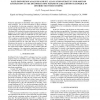Free Online Productivity Tools
i2Speak
i2Symbol
i2OCR
iTex2Img
iWeb2Print
iWeb2Shot
i2Type
iPdf2Split
iPdf2Merge
i2Bopomofo
i2Arabic
i2Style
i2Image
i2PDF
iLatex2Rtf
Sci2ools
ICIP
2007
IEEE
2007
IEEE
Rate-Distortion Analysis and Bit Allocation Strategy for Motion Estimation at the Decoder using Maximum Likelihood Technique in
Numerous approaches for distributed video coding have been recently proposed. One of main motivations for these techniques is the possibility of achieving complexity tradeoffs between the encoder and the decoder that may not be feasible in the context of conventional video coding. In our previous work, a Maximum Likelihood (ML) method for motion estimation at the decoder was proposed. It was shown that the ML method, designed based on the PRISM architecture, induces no additional rate cost, and is able to work with existing methods, e.g. those based on hash functions or CRC, to improve overall decoding PSNR. In this work, we present a rate-distortion analysis of our ML method. This analysis, given a correlation model for the video data, allows us to improve bit allocation at the encoder, i.e., the decision on the number of cosets to be used to represent various types of video information. We also signal “End of Block” (EOB) in coding to further exploit the energy compaction. Our e...
| Added | 03 Jun 2010 |
| Updated | 03 Jun 2010 |
| Type | Conference |
| Year | 2007 |
| Where | ICIP |
| Authors | Ivy H. Tseng, Antonio Ortega |
Comments (0)

